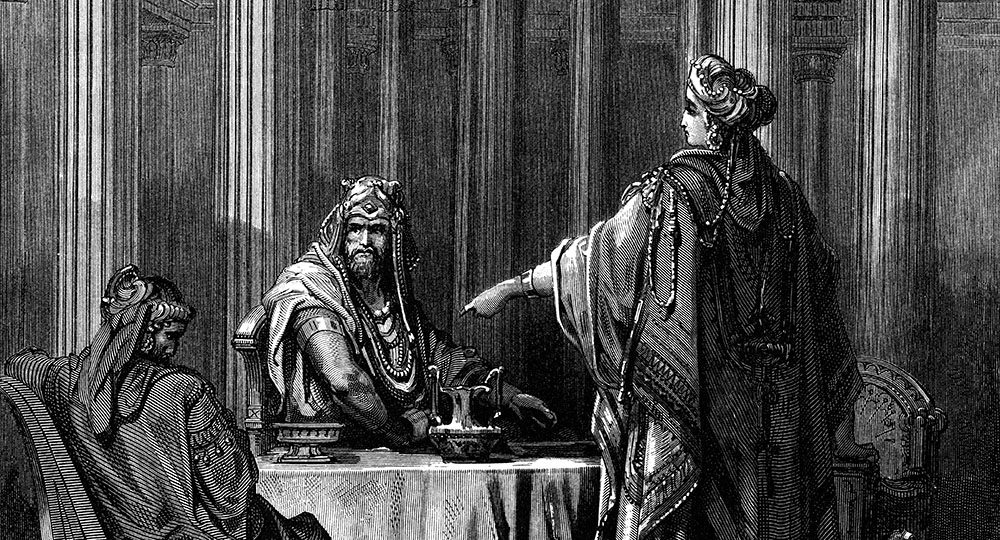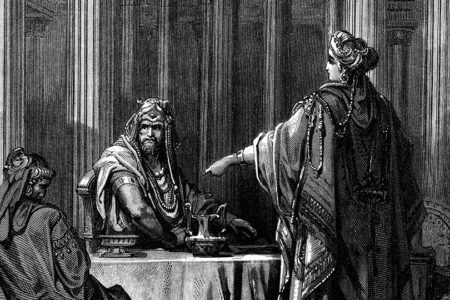Assessing the Return of Haman
The more things change, the more they stay the same. And if we don’t believe that axiom, we can look at Persia—now called Iran.
People visiting Israel during the annual Purim celebration in March, when masses of costumed Israelis joyously parade through the streets, might liken the event to America’s raucous observance of Halloween. But the comparison would be grossly inaccurate.
Purim has nothing to do with make-believe goblins or ghoulish apparitions prowling neighborhoods on All Hallows’ Eve. That tradition was bequeathed to the West by the ancient Celts who ignited bonfires and wore outlandish costumes in an attempt to ward off evil spirits at the end of the harvest.
The origin of Purim resides in historical reality, dating back some 2,500 years to the massive, ancient Persian Empire that spanned from India to Ethiopia and into portions of what is now Greece.
THE FEASTS OF ISRAEL
To learn more about Purim and other Jewish feasts, check out The Feasts of Israel by Elwood McQuaid.
The Purim account appears in the biblical book of Esther. Most intriguing about the affair is that the crucial elements in the beautiful true story of the orphan who became queen live on in vivid detail at this moment in history.
The Tale Unfolds
The man on Persia’s throne at the time was Ahasuerus, otherwise identified as Xerxes I or Xerxes the Great, who reigned over 127 provinces from India to Ethiopia (Est 1:1).
Historians have described the king as quick-tempered, beset by excessive indulgences, and inadequate as a military leader. After he expelled Queen Vashti for refusing his command to display herself at an orgy before a gathering of drunken men, he chose Esther from among the land’s virgins and made her his queen: “The king loved Esther more than all the other women, and she obtained grace and favor in his sight more than all the virgins; so he set the royal crown upon her head and made her queen instead of Vashti” (2:17).
With the death of both her parents, young Esther had become the ward of her cousin Mordecai, who had stepped in to raise her as his own daughter (v. 7). Mordecai was the great-grandson of a Benjamite Jew named Kish, who had been taken into captivity “with Jeconiah king of Judah, whom Nebuchadnezzar the king of Babylon had carried away” (v. 6).
Mordecai’s strength lay in the fact that, although in exile far from home, he never forgot who he was or disregarded his bond with the Jewish people scattered among the 127 provinces of the sprawling Persian Empire.
Haman entered the scene as the foremost vizier, the highest official under the king: “King Ahasuerus promoted Haman, the son of Hammedatha the Agagite, and advanced him and set his seat above all the princes who were with him” (3:1).
Haman brought with him a deep-seated hatred of the Jewish people that is perhaps explained by his descent from Agag, the king of the Amalekites, who were entrenched enemies of Israel as far back as the days of Moses, Joshua, Saul, and King David. Consequently, Haman’s wrath was not limited to Mordecai alone, who refused to bow before him in the king’s gate. Haman hated all Jews, and his intense feelings prompted him to fashion a decree of genocide that would have destroyed world Jewry because all Jewish people in that day lived within the Persian Empire.
Haman told Ahasuerus, “There is a certain people scattered and dispersed among the people in all the provinces of your kingdom; their laws are different from all other people’s, and they do not keep the king’s laws. Therefore it is not fitting for the king to let them remain. If it pleases the king, let a decree be written that they be destroyed” (vv. 8–9).
For Such a Time . . .
The drama that unfolded exhibits all to be desired in courage, unqualified commitment, and the will to survive.
Mordecai’s words to Esther in revealing Haman’s nefarious plot and its potential consequences for their people exemplify both faith in God’s intervention and an understanding of what it means to be the right person in the right place at the right time:
Do not think in your heart that you will escape in the king’s palace any more than all the other Jews. For if you remain completely silent at this time, relief and deliverance will arise for the Jews from another place, but you and your father’s house will perish. Yet who knows whether you have come to the kingdom for such a time as this? (4:13–14).
Esther knew entering the king’s presence uninvited could yield a fate much worse than Vashti’s. But she decided to go anyway. Her now-immortal conclusion was, “I will go to the king, which is against the law; and if I perish, I perish!” (v. 16).
The Rest of the Story
Haman’s plea to Ahasuerus to slaughter all of Persia’s Jews had been granted and was sealed in a document that could not be rescinded. As an added incentive, the executioners received permission to steal their victims’ goods: “Letters were sent by couriers into all the king’s provinces, to destroy, to kill, and to annihilate all the Jews, both young and old, little children and women, in one day, on the thirteenth day of the twelfth month, which is the month of Adar, and to plunder their possessions” (3:13, emphasis added).
Unfortunately for Haman, when Ahasuerus finally learned he had agreed to annihilate his own queen’s people, he had Haman hung on the gallows the vizier had prepared for Mordecai; and he gave the Jews permission to defend themselves—that is, to fight for their lives.
The results of the ensuing struggle exposed the extent of the Jew-hatred held by some in the kingdom. No fewer than 75,000 Persians were cut down during the fighting. An interesting aside is that the Jewish people “did not lay a hand on the plunder” (9:10). The fight was not about taking a spoil; it was about the right to live.
Haman’s Return
After an astonishing 2,500 years of continuous monarchical Persian rule, Ayatollah Ruhollah Khomeini ousted the last of the monarchs, Mohammad Reza Shah Pahlavi, in the 1979 Islamic revolution. The country’s seizure by Khomeini and radical Muslim mullahs heralded the symbolic return of Haman, whose rant, “death to the Jews,” would ring out once again.
In fact, Haman could not have stated the case more clearly than the compatriots in Tehran.
Iran’s current supreme leader, Ayatollah Ali Khamenei, has repeatedly declared that Israel must be destroyed. He even took to Twitter to spew his vitriol: “This barbaric, wolflike & infanticidal regime of #Israel which spares no crime has no cure but to be annihilated.”1
Mohammad Hassan Rahimian, Khamenei’s representative, agrees: “We have manufactured missiles that allow us, when necessary to replace [sic] Israel in its entirety with a big holocaust.”2
And while the central focus remains on Israel and its Jewish citizens, the United States and Western nations are not exempt from the radical Islamist quest to conquer and destroy. Even in 2006, Iranian leader Ali Khamenei said on Iranian television,
Today, America poses a threat to peace and security in the world. Therefore, the slogan “Death to America” is no longer used only by our people. Today, you see throughout the world people setting fire to the effigy of the American president and chanting the slogan “Death to America.” This is because of the American regime’s exaggerated demands, its arrogance, its vanity, and its desire to control, and because it is a pawn in the hands of the Zionists.3
Iran’s current leaders entertain expansionist dreams far beyond what Xerxes envisioned when he launched military campaigns to conquer Greece and expand his empire. Ayatollah Khamenei has made it clear. In an online article, Eliot Assoudeh, a PhD candidate in political science, summed up the Islamic intent: “The Islamic Revolution in Iran had five goals to achieve, as stated by its current supreme leader, Ayatollah Ali Khamenei: the revolution, formation of the Islamic system, formation of the Islamic state, formation of the Islamic nation and formation of the Islamic civilization.”4
When costumed children of the 21st century gather to cheer Queen Esther and jeer Haman in 2019, it’s as much a testimonial to present reality as it was thousands of years ago. And perhaps as today’s Purim is celebrated in an Israel dotted with bomb shelters, we should remember that evil never disappears; it only pauses from time to time.
As it was in ancient Persia, Israelis have the ability to strike back. Those harboring Haman’s passion to destroy the Jewish people may end up making a trip to the
gallows themselves.
ENDNOTES
-
- JPost.com staff, “Khamenei on Twitter: No Cure for Barbaric Israeli Regime but to be Annihilated,” JPost.com, November 9, 2014 <tinyurl.com/ybn76tkb>.
- Jeffrey Goldberg, “The Iranian Regime on Israel’s Right to Exist,” theatlantic.com, March 9, 2015 <tinyurl.com/y9jb29px>.
- “Iranian Leader Ali Khamenei: The Slogan ‘Death to America’ Is No Longer Chanted Only by the Iranians,” Middle East Media Research Institute (MEMRI) TV Monitor Project, memri.org, March 21, 2006 <tinyurl.com/ycbp85dy>.
- Eliot Assoudeh, “Iran’s Quest for a New Islamic Civilization,” fairobserver.com, May 3, 2017 <tinyurl.com/y9k7dlar>.










Is there anything wrong with understanding the scripture in the context of the culture?
“After he expelled Queen Vashti for refusing his command to display herself at an orgy….”
I don’t see anywhere in the book of Esther that there was an orgy. I read that the King held a banquet for the men, and the Queen held a banquet for the women.
We should rely on the text of the bible, and not theories based on scholars and rabbinical traditions to try and prove something or get a point across to get support for your point of view. Accuracy is important. So is truthfulness.